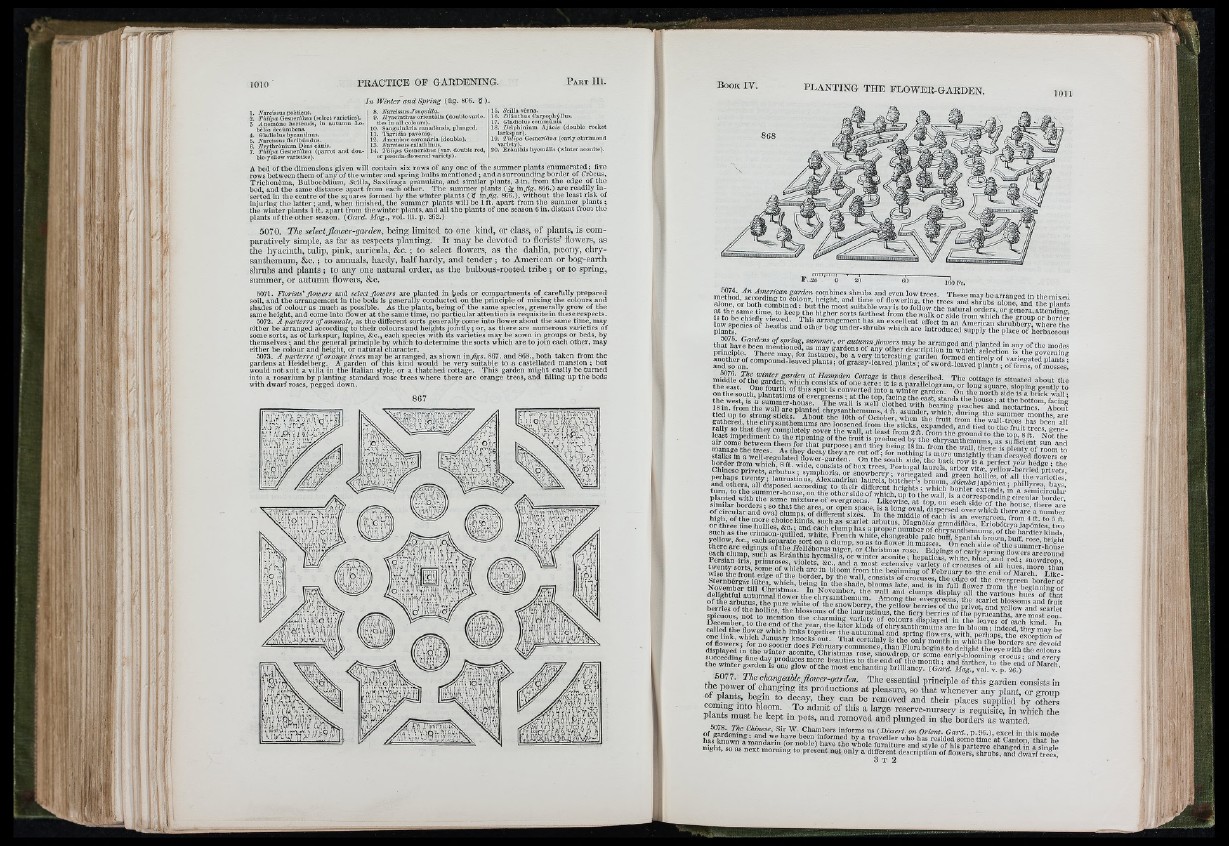
■f
Il
l i f e .
f ii'
I! ife
ij
; ; i
» '
»'■il',
1. Narcissus poéticus.
2. T ù lip a OeBiieridna (select varieties).
S Anemòno hortfensis, in a u tum n Lob
è lm dccùmbens.
4. Gladiolus byzantinus.
5. Narcissns floribimdus.
6. N ry th rò n ium Déns cànis.
7. Tiilip a GesneridMrt (p a rro t an d double
yellow varieties).
I n W in te r a n d S p r in g (fig. 8f6. ? ) .
8. Narcissus Jonguilla.
9. Ny ac in th u s o rien tàlis (double varieties
in ail colours).
15. ic illa vérna.
16. D ià n th u s Caryopliyllus.
17. Gladiolus communis.
18. D elp h in ium Ajàci# (double rockot
la rk sp u r).
19. T id ip a Gesneridan (early clarimond
variety).
20. E rà n th is hyemàlis (winter aconite).
10. San g u in à ria canadénsis, plunged.
11. T ig rid ia pavònia.
12. Anemòne co ronària (double).
14. T ù lip a Gosneridno ré*»", double red,
o r ptconla-flowered variety).
A bed of th e dimensions given will contain six rows of any one of th e summer plants enume rated; five
rows between them of any of the w inter and spring bulbs m entioned; and a surrounding — . . . — „..OT rt*-... ---IPX.- ] _ ? !1___ T — OT - O ff.--.—b oOTrl, drts errt. ,1o rf-r ,C r6cOuTH" Trichonèma,' BurbocVdïuni', Scílla, Saxífraga granulàta, and similar plants, 3 in. from th e edge of foe
bed, and the same distance apart from each other. The summer plants (â î ^'ùfig-inserted
in the centre o fth e squares formed by the winter plants ( if ir tjig . 866.),without th e least risk of
injuring the latter ; and, when finished, the summer plants will be 1 ft. apart from the summer plants ;
th e winter plants 1 ft. apart from the winter plants, and all the plants of one season 6 in. distant from the
plants o fth e other season. {G a rd . M a g ., vol. iii. p. 262.)
5070. T he select Jiow er-g ard en, being limited to one kind, or class, of plants, is comparatively
simple, as far as respects planting. It may be devoted to florists’ flowers, as
the hyacinth, tulip, pink, auricula, &c. ; to select flowers, as the dahlia, pæony, chrysanthemum,
&c. ; to annuals, hardy, half hardy, and tender ; to American or bog-earth
shrabs and plants ; to any one natural order, as the bulbous-rooted tribe ; or to si>ring,
summer, or autumn flowers, &c.
5071. F lorists' J lowe rs and select J lowers are planted in or compartments of carefully prepared
soil, and th e arrangement in th e beds is generally conducted on the ' ............--->
shades of colour as much as possible. As th e plants, being of the
same height, and come into flower a t th e same time, no particular a
5072. A p a r te r r e o f a n n u a ls , as th e different sorts generally come into flower about th e same time, may
either be arranged according to their colours and heights jointly ; or, as there are numerous varieties of
some sorts, as of larkspur, lupine, &c., each species with its varieties may be sown in groups or beds, by
themselves ; and the general principle by which to determine the sorts which are to join each other, may
either be colour and height, or natural character.
5073. A p a r te r r e o f ora n g e trees may be arranged, as shown in .^ s . 867. and 868., both taken from the
gardens a t Heidelberg. A garden of this kind would be very suitable to a castellated mansion ; but
would not suit a villa in th e Italian style, or a thatched cottage. This garden might easily be turned
into a rosarium by planting standard rose trees where th ere are orange trees, and filling up th e beds
with dwarf roses, pegged down.
867
in /ig . 866.) are readily in-
.), witho- ' ' • •• -
lUU f t .
5075. G ardens o fsp r ii
th a t have been mention^
principle. —
an o th e ro fc
and so on. " ■ * ’ — ui icms, <ji musses,
mfddte ‘i>»
tcie west, IS a summer-house The wall is well* ointhJA V. ffH ifefe • ® ; at tne bottom, facing
l a r t h . ^ OT I ® ‘'•ora the sticks, expanded, and tied to foe ffeu'it tree
K forapletely cover the wall, a t least from 2 ft. from th^ ground to th / toE 8 It
manage the trees. As they >
stalks mff— —a — w ellU- :r _eLg url. a/OtT ed f• io1
dispersed over which IL r f e f e ’a 'n 'u fe fo
each clump, such a- •
Persian iris,
twenty sorts,
t h / k r / "/ g t 't t b le jlo w e r-g a rd m . The essential principle of this garden consists in
of r d Z f I “s productions at pleasure, so that whenever any plant, or group
Ot plants, begin to decay, they can be removed and their places supplied bv othera
night, so as next morning to present not only a different description of flowers, shrubs, and dwarf trees
3 T 2 ’